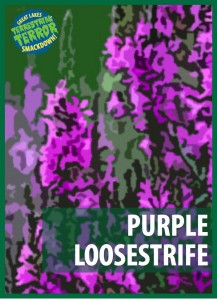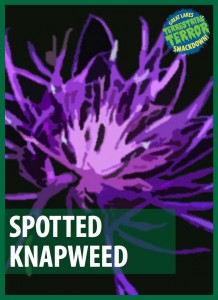Editor’s note: Great Lakes SmackDown Terrestrial Terror is an ongoing Great Lakes Echo series. Brackets can be filled out until Friday, March 18. Find more information here.
By Alice Rossignol and Rachael Gleason
It’s time for the plants and plant-killing exotics to take root in the SmackDown.
PURPLE LOOSESTRIFE vs. GARLIC MUSTARD
The purple loosetrife may be strikingly beautiful but watch out. This so called “Purple Plague” invades, out-competes and destroys. Standing up to 8-feet tall this beauty likes to socialize in bunches of plants that choke out native plants and wildlife. And trying to cure this plague for good is the garlic mustard. Known to fellow plants as “Colonel Mustard” this European plant dominates the forest floor, and changes the habitat composition for native species.
Fighter Profiles:
 Alias: The Purple Plague
Alias: The Purple Plague
Legal name: Lythrum salicaria
Home Turf: Eurasia, from Great Britain to Central Russia, and Asia, including Japan, Korea, Southeast Asia, northern India and the northern Himalayan region
U.S. Fighting Debut: Early 1800s in the United States; 1869 in Lake Ontario (Great Lakes)
Agent: Ballast water and canals. Also spread by wind, mud adhering to wildlife, livestock, vehicle tires, boats and people.
Preferred Great Lakes fighting arena: All eight Great Lakes states
Weight/Size class: Can grow up to 8 feet tall. Forms social cliques of 5-foot-tall plants
Fighting Skills:
- This tall and striking purple plant uses its beauty as a deadly tool. It entices unsuspecting horticulturists to use it for landscape and bee-keeping projects.
- The aggressive and competitive purple loosestrife forms a dense net that choke out native grasses and flowering plants and destroy habitat for waterfowl and other wildlife at impressive speeds.
- While it prefers the rich, highly organic soils, it can settle anywhere and withstand up to 50 percent shade and shallow flooding.
Life Expectancy: The plant dies quickly each fall; decomposing leaves can negatively impact natural wetland function and animal populations that feed on decaying plant matter.
Offspring: Flowers 8-10 weeks after spring growth; seeds can mature even if submerged for two to three years.
 Alias: Colonel Mustard
Alias: Colonel Mustard
Legal name: Alliaria petiolata
Home Turf: Europe
U.S. Fighting Debut: 1800s
Agent: Originally used in the U.S. for food and medical uses.
Preferred Great Lakes fighting arena: All Great Lakes states and provinces.
Weight/Size class: 3 to 4 feet high.
Fighting Skills:
- Takes advantage of disturbed areas where trees have been removed such as trails and roadsides.
- A rapid sprawler, in some areas in Illinois its recorded spreading up to 120 feet per year.
- One the Colonel decides to put down roots, its committed, and becomes a permanent resident of that plant community.
- Displaces native plants and causes lower plant diversity, while hogging the ground layer of the ecosystem.
- The presence of garlic mustard can change the composition of habitats like growing taller than native plants and butterflies mistaken lay their larvae on.
Life Expectancy: Two years.
Offspring: One plant produces between 50 and 7,900 seeds. Seeds remain viable in soil for up to 5 years.
SPOTTED KNAPWEED vs. BEECH SCALE
With a toxic personality, the Spotted Knapweed can poison other plants, irritate human skin and crowd out native plants Nicknamed “The Knapster,” this biennial snatches up various habitats like road ditches, railroad beds and Great Lakes dunes. Up against “The Knapster,” is the Beech Scale. Hardly a “fun-guy” this insect is the main player in the destructive “Beech Bark Disease.” Living up to its alias “The Bark Butcher” it decimates beech trees with the help of a fungus in parts of the Great Lakes region.
Fighter Profiles:
 Alias: The Knapster
Alias: The Knapster
Legal name: Centaurea stoebe
Home Turf: Europe
U.S. Fighting Debut: Late 1800s
Agent: Accidentally either through contaminated seeds or ballast water.
Preferred Great Lakes fighting arena: All Great Lakes states and provinces.
Weight/Size class: 3 to 4 feet tall.
Fighting Skills:
- This plant has a toxic personality because it’s phototoxic – toxic to other plants.
- Don’t let this plant get under (or on) your skin because it can cause skin irritation in humans.
- With no sense of personal space, this weed crowds out other plants like those that livestock eat.
- Home is where it sets its roots. This plant takes advantage of various habitats like Great Lakes dunes, road ditches, railroad beds, prairie sites, and oak and pine barrens.
- Knapweed infestations can increase surface run-off and sedimentation in some areas.
Life Expectancy: About two years. But seeds in the ground remain capable of germinating for up to 7 years.
Offspring: An average plant creates 1,000 seeds a year.
 Alias: The Bark Butcher
Alias: The Bark Butcher
Legal name: Cryptococcus fagisuga
Home Turf: Europe
U.S. Fighting Debut: Michigan in 2000 and Wisconsin in September 2009
Agent: Accidental introduction by an unknown agent.
Preferred Great Lakes fighting arena: Michigan, Wisconsin and Ontario
Weight/Size class: 1 mm long
Fighting Skills:
- The Beech scale isn’t a “fun-guy” at all. The invasive critter feeds on tree sap, which paves the way for destructive fungi to invade unsuspecting trees. The resulting condition is referred to as the “Beech Bark Disease,” a growing problem in Great Lakes states.
- Dead trees ravished by the disease are a threat to campers. Although necessary, it’s difficult and costly to remove infested trees and branches.
- As Beech scales are feeding on tree sap, their legs become stuck to the surface. They spent their last moments tragically trapped by their own gluttony.
So will it be Colonel Mustard, in the forest with the pistil, or maybe The Bark Butcher with the fungus among the beech trees?
